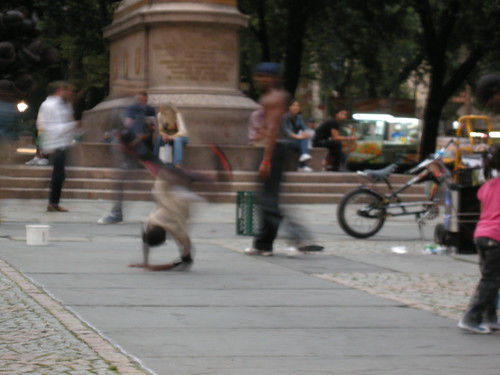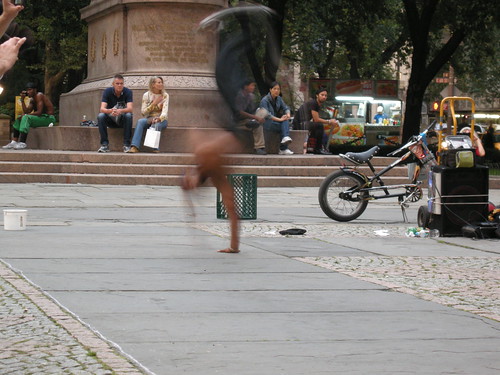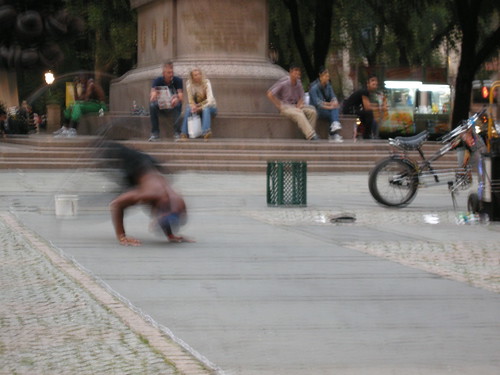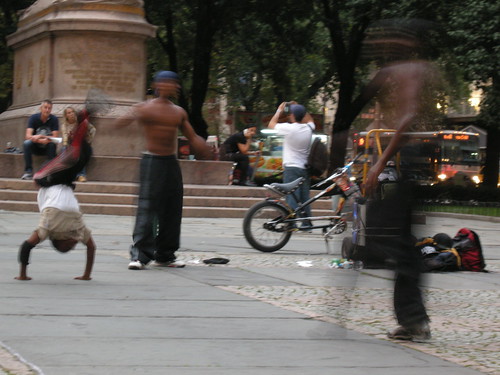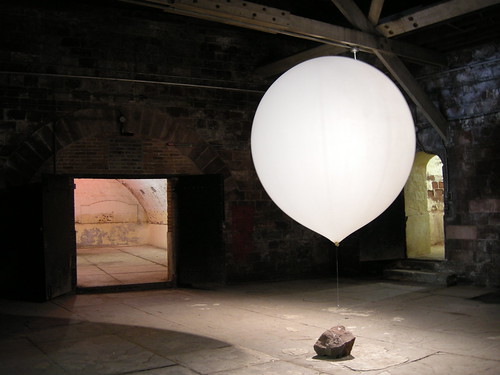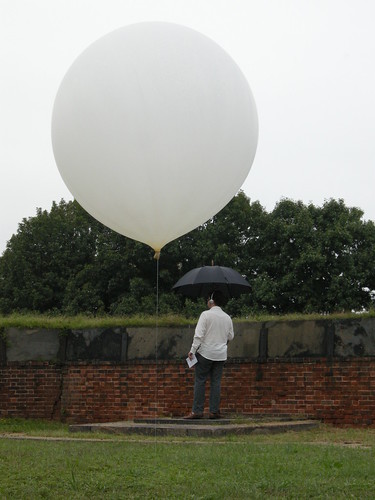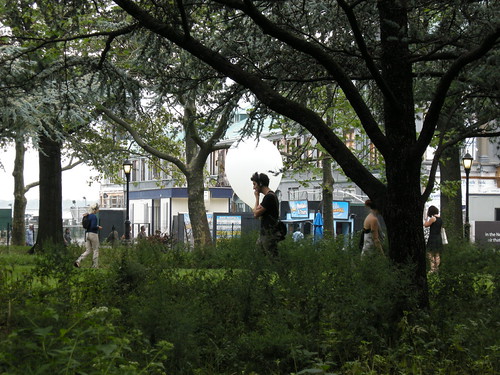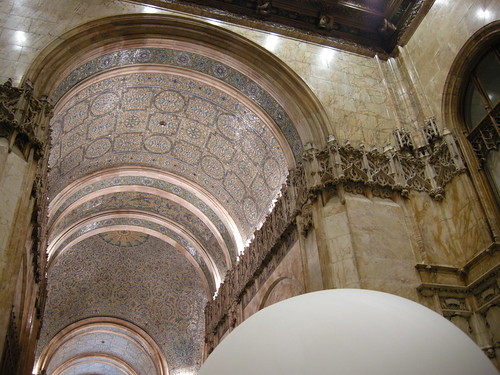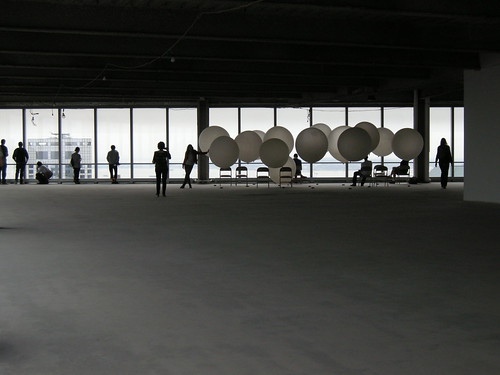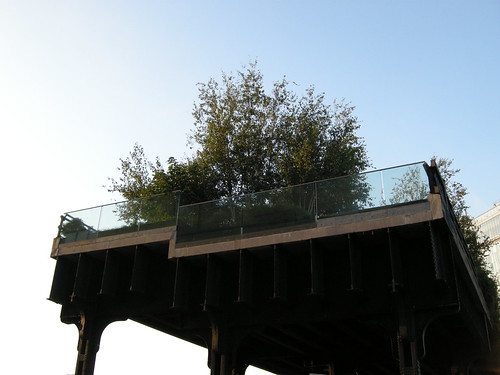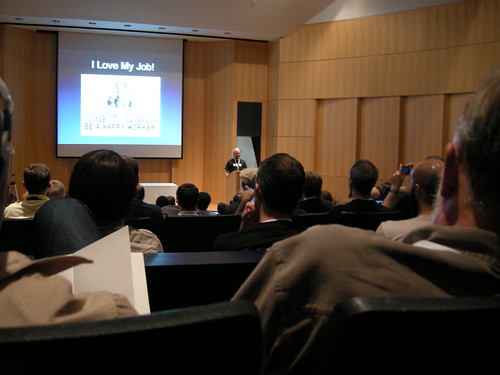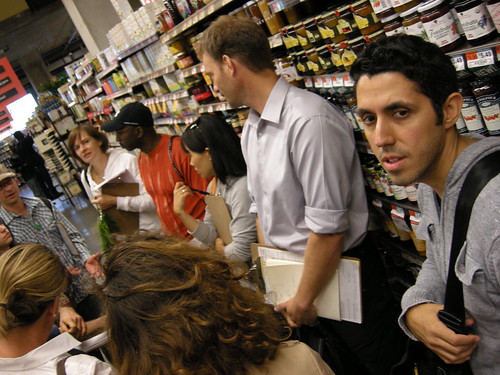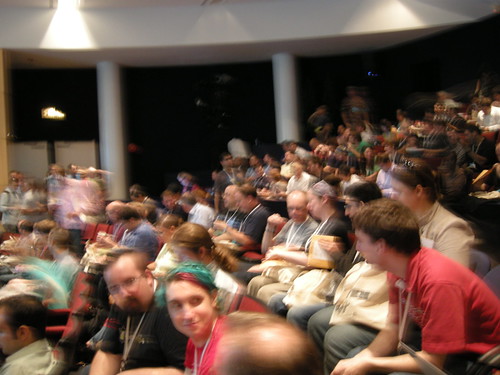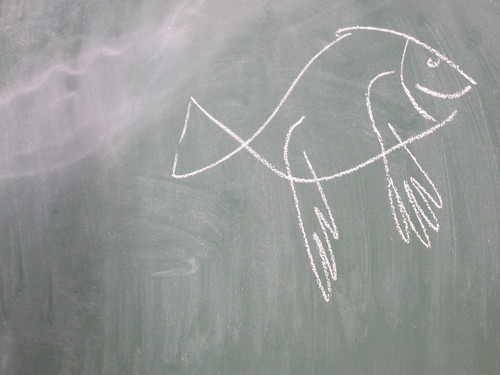GPS parallelograms
Not entirely what I’d expected when I went out to test the homebrew GPS system today…

Several hours meandering around Central Park rendered as 10,000 small lines mostly aligned in one of two directions
What’s going on there, then?
Bodies in motion
I was thinking it’d be interesting to have the beats in time to the movement instead of the other way around; has anyone done that Kinect hack yet?
To a Great City (and magnificence)
Whilst prowling the corridors of ITP yesterday, I chanced upon a second great project by the Guggenheim: stillspotting ( ) nyc.
The current iteration is located in the borough of Manhattan and features a collaboration between composer Arvo Pärt and the New York City and Oslo-based architectural firm Snøhetta.
Five sites have been selected, each with a musical piece and one or some large weather balloons installed at them. Each provide space for contemplation and slowing down.
Each of the locations were something special in their own right – you can see a slideshow of all my photos – and the addition of gorgeous compositions resulted in some moving experiences.
Several times I was also aware of how we looked from the outside – particularly at those sites where the musical accompaniment was secret to us, listened to via headphones.
It brought to mind recent conversation with Hannah Nicklin about creating ‘magnificent moments’, but I’m still trying to decide if these were they or not…
Running repairs
I brought one of the sets of electronics that drive the Colony creatures to New York, but some of the wiring broke and oops, if I didn’t forget to bring a soldering iron with me (I know, I know…)
Not a problem though! Tonight I popped over to the NYC Resistor craft night and used one of theirs.
I was also able to use their workshop to put together some wooden mounts that the wires are now fed though and the GPS modules attached to, so they should now be able to survive any amount of walking, being stuffed in bags and secreted about my person that I can throw at them over the next few weeks!
Tile typography
I’m completely in awe of the person who, when asked to make a bazillion mosaic station name signs to go in an underground tunnel somewhere, took the time to make something as beautiful as this.
Who, I mean who, would have the patience to do all those sloping serifs and tapered whatever-those-bits-are-calleds?
Glad they did, though.
And the 8s; they’re pretty special too.
All comparisons between The High Line and Duddeston viaduct end here:
Try going via the Koganecho Bazaar instead.
~~~~~~~~~~~~~~~~~~~~~~~~~~~~~~~~~~~~~~~~~~~~~~~~~~~~~~~~~~~~~~~~~~~~~~~~~
The High Line
Duddeston Viaduct
Redhawk Logistica’s Duddeston Viaduct project
Spaces for learning
On Thursday I attended the Open Hardware Summit and listened to presentations that underlined the importance of different frameworks and approaches to allow innovation to happen. Here I also went to the Open Hardware in Education breakout session.

Live Feeds FeedForward Fieldwork 7: Migrations and Immigrations—Mapping Movements and Power by spurse
On Friday I returned to the Guggenheim Lab and joined Spurse and a group of strangers in co-constructing a tour of the local area in an attempt to answer a set of research questions linked to migration/agents of change.
I was in a group of 5 investigating the identity of the honey bee. I learned a lot as we first pooled our knowledge and then presented our contribution to a tour with the other groups.
On Saturday and Sunday I was at the World Maker Faire. Apart from being surrounded by exhibits and hands-on workshops that exemplified the sort of discipline-linking, world-shifting creativity that we’d talked about elsewhere earlier in the week, I also went to several presentations.
Two in particular addressed this common thread of spaces for learning: Hackerspaces: Schools of the Future and DIY U: Designing Self Organized Education.
These, along with your own testimonials, are helping me to put into context what we achieved with fizzPOP (and to some extent BARG too) in terms of making alternative spaces for learning and the importance of that.
Hackerspaces: Schools of the Future
Hacker and Maker spaces provide passion-based education that many of us missed in traditional education systems. The learning which takes place in these spaces is intergenerational, transdisciplinary, and multi-intelligent. A panel of hackerspace founders will ask how these alternative education venues can be recognized as a legitimate route to certification, how they propagate knowledge across the culture, and how they avoid becoming dull and co-opted. With Mitch Altman (TV-B-Gone), Willow Brugh (Space Federation), Jimmie Rodgers (Bucketworks and The School Factory), James Carlson (Schoolfactory.org), and Jon Santiago (NYC Resistor)
.
The first thing to note was how chair James Carlson positioned his spaces as school factories (as in things that new models of schools would eventually come out of) and as ‘healthclubs for the brain’.
The panel talked in detail about their responses to mainstream education and how hackspaces were providing learning spaces that didn’t silo people according to age or discipline, but instead provided opportunities for people to learn about the things they wanted to learn about and opportunities for people to discover things they didn’t know they wanted to learn about.
We talked about meritocracies, do-ocracies and being able to share the joy of achievement. We talked about how sometimes the best teachers are those that have only just learned, not those that have been competent for 20 years. We talked about the importance of high tables and being able to ping around between different workspaces. We talked about the process of learning being important, not so much the content which is only a small part of the story. We talked about the inspiration that comes from being around other people who are doing. We talked about measuring growth and how we automatically know how we’re doing anyway – no need to add grades on top of that. We talked about how to teach failure. We talked about how many schools are stuck and how hackspaces can provide alternative spaces free from baggages of the roles people have fallen into within their usual learning environments.
DIY U: Designing Self Organized Education
How do we teach, learn, and credential each other outside the logic of traditional educational institutions?
We talked about universities as unyielding structures of education based on the concept of knowledge being scarce. We talked about communities of practice and how legitimate, peripheral participation can lead to being a master of a skill. We talked about how in this system, as soon as you have taken the first step in, you automatically have a responsibility to help those that come behind you. We talked again about content as a framework. We talked about education being the sum of content (what we learn) + socialisation (how we learn) + accreditation (which for many has become the why we learn). We talked about how “how to” searches are amongst the most popular on Google and YouTube – and how people are sharing their knowledge. We talked about tradeschool and investing some of your time and talent to get someone else’s. We talked about the social nature and value of exchange. We talked about how bartering for skills (rather than paying for them with money) also led to forming ongoing relationships with peers. We talked about how people are finding ways to make knowledge gained in the do-ocracy realm count towards credit in the traditional realm. We talked about different macro and micro scales of education. We talked about the risks of network-based learning. We talked about being committed to each other.
~~~
As I get more of the bigger picture that accompanies my own small experiences and experiments, I’m increasingly thinking I’d like to see a hackspace – and all that it entails and all that it might entail – being supported by something like the NESTA Digital R&D Fund. These are spaces that get people involved, that make innovation happen and that need to be explored and made sustainable. Can we make that happen?
Open Hardware Summit
Selected extracts from my notes from the Open Hardware Summit that could just have easily have come from the Guggenheim Lab workshop the day before.
- Change is painful.
- Expect resistance.
- Mistakes will get institutionalised.
- Even your friends might become a competitor.
- Things will get used differently to how you intended.
- Ideas spread and change.
- Interesting things happen at the edges, with systems that are porous and when you move between different fields.
- What you think of as being possible is dictated by your past experience.
- As time progresses, so should your tools.
- People will use the technology in ways you cannot predict, so you need to build it to be open and flexible.
When the earthworm hits, the consequences are massive
On my first day in New York I was wandering around Downtown when I happened to catch a glimpse of a flyer taped to a lamp post. Something about it made me stop, walk back a few paces and take a closer look. I didn’t take that close a look: seeing the words “Guggenheim”, “lab” and something to do with your local area was enough to make sure I Googled it when I got back home that evening.
Glad I did.
The BMW Guggenheim Lab is a mobile laboratory traveling to nine major cities worldwide over six years. Led by international, interdisciplinary teams of emerging talents in the areas of urbanism, architecture, art, design, science, technology, education, and sustainability, the Lab addresses issues of contemporary urban life through programs and public discourse. Its goal is the exploration of new ideas, experimentation, and ultimately the creation of forward-thinking solutions for city life.http://www.bmwguggenheimlab.org
My kind of people!
I’m signed up for various things on the programme of events and workshops with the first of them having been today: Mapping Movements and Power.
The lab is situated in a small city park. Well, the cafe and the loos are; the main structure itself slots into the gap where I assume a building once stood, so that the gaffiti’ed outer walls of the two remaining buildings stood either side form part of the walls of the lab.
It felt good to be in this void space so close to large, busy roads but reclaimed for discussion, debate and thinking.
And we did a lot of thinking this afternoon.

50 brains thinking about movement and power
After an introduction to the migrant earthworm – stowaways from Europe transported in the ballast of ships – four groups were each given a task. Not the usual starting point, but one to make us “start somewhere else to get somewhere else”.
- What makes a species invasive?
- How does your identity produce rights?
- Describe 3 basic types of movement.
- What should the setting of democracy look like? (ie the space it should happen in)
I was in the first group and it turns out that trying to define what an invasive species is is quite tricky! After chewing over the semantics and accompanying baggage of negative and/or conquering connotations, my understanding of a possible definition of an invasive species got distilled down to something like “agents of change (within a specific temporal and spatial frame) that transform one equilibrium to another”.
This definition and our other initial thoughts were then to be challenged as we applied them to fish with legs and rampant zebra mussels.
I’m not going to try and reproduce those lines of thought here, just note down a few things that seemed to resonate.
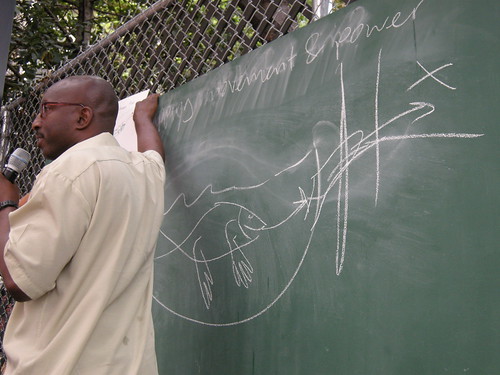
A teenage fish with legs leaves fish world, enters land world and radically changes both worlds as a result.
When tools developed for one situation (ie for being a better fish in water) are applied to a new environment (ie land), new possibilities open up. When tools are applied to a new system they can induce radical changes, rather than the changes-by-degrees they can affect in their originating system.
You don’t know you are catalysing the change of worlds when you do it.
We can’t see the future beyond the change.
Equilibrium is an illusion – there is no fixed state of “before” that we can go back to.
When the change comes about, not only can you not foresee your wants and needs in the new world, but your measures of value will be out-dated too.
Zones of transition are where the evolution happens. Should we be preserving the forest fringes in order to preserve the sites where innovation happens? Can we take that a step further and promote conditions for forest fringes to form?
When the earthworm hits, the consequences are massive.

